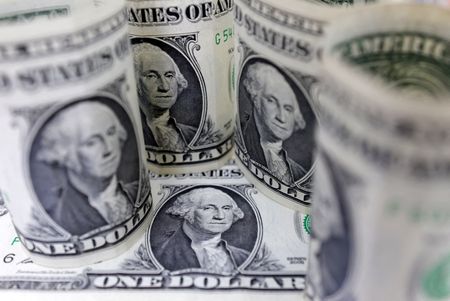(Updates prices, adds commentary)
By Sinéad Carew and Joice Alves
NEW YORK/LONDON (Reuters) – The U.S. dollar gained against the yen and the euro on Monday but pulled back from its highs of the day with investors betting on a slower pace of Federal Reserve interest rate hikes going forward.
The dollar index was higher after falling 4% last week, marking its biggest weekly drop since March 2020, after data showing U.S. consumer prices rose less than expected in October and prompted bets for slower hikes.
While the greenback appeared to benefit earlier on Monday from hawkish investor readings of weekend comments from Fed Governor Christopher Waller, it lost some ground as the session wore on as investor hopes for slower hikes were renewed by Fed Vice Chair Lael Brainard’s comments on Monday.
Waller said on Sunday that the Fed could now start thinking about hiking at a slower pace but cautioned that the inflation data was “just one data point” and that other readings are needed to show a convincing slowing in price gains.
While Brainard emphasized in an interview with Bloomberg that the Fed has more work to do, she signaled that it will likely slow its tightening pace soon as it figures out how high borrowing costs need to go and for how long in order to bring down inflation.
“Markets here are starting to really factor in the top of the Fed cycle,” said Shaun Osborne, chief FX strategist at Scotiabank in Toronto, pointing to last week’s U.S. inflation reading as solid grounds to believe it can move lower.
And he noted that Brainard’s comments boosted equity sentiment, which dragged on the dollar on Monday.
“Now that the end the end of this tightening cycle is become a little clearer for investors and there’s more confidence equity markets can continue to improve that’s likely to undercut the U.S. dollar to an extent,” he said.
“We have been looking for at least a moderation in the dollar rally. That seems to be developing now and the scale of moves last week does suggest that the dollar may be poised for a bit more softness in the short run at least.”
Investors had seen Waller’s comments as cold water on hopes for a “rapid Fed recalibration,” said Adam Button, chief currency analyst at ForexLive in Toronto.
This had helped the dollar index, which gauges the greenback against a basket of six other major currencies including the euro, yen, and sterling, rise as much as 0.93% to 107.274 before it pulled back to last trade up 0.4% at 106.73.
The euro was last down 0.01% against the dollar at $1.0342, after earlier rising to a three-month high of $1.0368.
GRAPHIC-Euro slides after hitting 3-month high against the U.S. dollar https://fingfx.thomsonreuters.com/gfx/mkt/lbpggnrenpqEUROUSD.png
ECB board member Fabio Panetta said on Monday that the central bank must keep raising rates but needs to avoid overtightening, as doing so could destroy productive capacity and deepen an economic downturn.
Data had showed on Monday that euro zone industrial production rose much more than expected in September, and output for August was revised upwards too. Economists said that may be partly due to manufacturers front-loading production before energy-related disruptions this winter.
Sterling fell ahead of British Chancellor Jeremy Gaunt’s autumn statement on Thursday when he is expected to set out tax rises and spending cuts. The pound was down 0.55% at $1.1770, having risen 4% in the previous two sessions, touching on Friday its highest level since late August.
Cryptocurrencies remained in turmoil after the fall of FTX. The crypto exchange’s token was down 7.8% on the day at $1.308, representing a 95% drop on a month-to-date basis.
Bitcoin had fallen as far as $15,784 earlier on Monday before recovering somewhat. It was last down 0.18% at $16,280.
China’s onshore yuan rose to nearly a two-month high against the dollar, coinciding with its central bank’s official guidance and a broad lift in Chinese market sentiment on moves to help its embattled property sector and a decision to ease some of the country’s strict COVID-19 restrictions.
Elsewhere, the dollar was last up 0.79% against the yen at 139.92 after earlier rising as high as 140.79.
The risk-sensitive Australian and New Zealand dollars regained lost ground after earlier slipping sharply against the greenback.
========================================================
Currency bid prices at 3:27PM (2027 GMT)
Description RIC Last U.S. Close Pct Change YTD Pct High Bid Low Bid
Previous Change
Session
Euro/Dollar $1.0342 $1.0347 -0.01% -9.00% +$1.0368 +$1.0272
Dollar/Yen 139.9200 138.7600 +0.79% +21.48% +140.7850 +138.4000
Euro/Yen 144.71 143.69 +0.71% +11.04% +145.2200 +143.4800
Dollar/Swiss 0.9421 0.9413 +0.11% +3.31% +0.9488 +0.9406
Sterling/Dollar $1.1770 $1.1835 -0.55% -12.97% +$1.1852 +$1.1714
Dollar/Canadian 1.3295 1.3251 +0.31% +5.13% +1.3309 +1.3240
Aussie/Dollar $0.6712 $0.6707 +0.07% -7.66% +$0.6723 +$0.6664
Euro/Swiss 0.9744 0.9747 -0.03% -6.03% +0.9777 +0.9728
Euro/Sterling 0.8785 0.8742 +0.49% +4.58% +0.8822 +0.8728
NZ $0.6111 $0.6121 -0.04% -10.61% +$0.6127 +$0.6065
Dollar/Dollar
Dollar/Norway 10.0120 9.9465 +0.67% +13.66% +10.0425 +9.9710
Euro/Norway 10.3540 10.2827 +0.69% +3.41% +10.3749 +10.2423
Dollar/Sweden 10.4638 10.3678 +0.69% +16.03% +10.4948 +10.3578
Euro/Sweden 10.8178 10.7439 +0.69% +5.75% +10.8414 +10.7256
(Reporting by Sinéad Carew in New York, Joice Alves in London; Editing by Alison Williams, Paul Simao and Lisa Shumaker)

